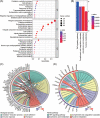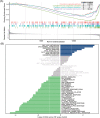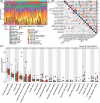Identification of key genes and immune cell infiltration in recurrent implantation failure: A study based on integrated analysis of multiple microarray studies
- PMID: 35929523
- PMCID: PMC9786880
- DOI: 10.1111/aji.13607
Identification of key genes and immune cell infiltration in recurrent implantation failure: A study based on integrated analysis of multiple microarray studies
Abstract
Problem: Recurrent implantation failure (RIF) refers to a challenging topic in assisted reproductive technology (ART), the etiology of which may be attributed to impaired endometrial receptivity; however, the precise pathogenesis of RIF has not been thoroughly elucidated.
Method of study: Four RIF microarray datasets were obtained from the Gene Expression Omnibus database and integrated by the "sva" R package. The differentially expressed genes (DEGs) were analyzed using the "limma" package and then GO, KEGG, GSEA, and GSVA were applied to perform functional and pathway enrichment analysis. The immune cell infiltration in the RIF process was evaluated by the CIBERSORT algorithm. Finally, the hub genes were identified through the CytoHubba and subsequently verified using two items of external endometrial data.
Results: 236 genes were differentially expressed in the endometrium of the RIF group. Functional enrichment analysis demonstrated that the biological functions of DEGs were mainly correlated to the immune-related pathways, including immune response, TNF signaling pathway, complement and coagulation cascades. Among the immune cells, γδ T cells decreased significantly in the endometrium of RIF patients. In addition, the key DEGs such as PTGS2, FGB, MUC1, SST, VCAM1, MMP7, ERBB4, FOLR1, and C3 were screened and identified as the hub genes involved in the pathogenesis of RIF.
Conclusions: Abnormal immune response regulation of endometrium contributes to the occurrence of RIF, and γδ T cells may be the pivotal immune cells causing RIF. At the same time, the novel hub genes identified will provide effective targets for the prediction and therapy of RIF.
Keywords: hub genes; immune cell infiltration; recurrent implantation failure.
© 2022 The Authors. American Journal of Reproductive Immunology published by John Wiley & Sons Ltd.
Conflict of interest statement
The authors declare no conflicts of interest.
Figures






References
-
- Thornhill AR, deDie‐Smulders CE, Geraedts JP, et al. ESHRE PGD consortium ‘Best practice guidelines for clinical preimplantation genetic diagnosis (PGD) and preimplantation genetic screening (PGS). Hum Reprod. 2005;20:35‐48. - PubMed
-
- Mak JSM, Chung CHS, Chung JPW, et al. The effect of endometrial scratch on natural‐cycle cryopreserved embryo transfer outcomes: a randomized controlled study. Reprod Biomed Online. 2017;35:28‐36. - PubMed
-
- Achache H, Revel A. Endometrial receptivity markers, the journey to successful embryo implantation. Hum Reprod Update. 2006;12:731‐746. - PubMed
-
- Bastu E, Mutlu MF, Yasa C, et al. Role of mucin 1 and glycodelin A in recurrent implantation failure. Fertil Steril. 2015;103:1059‐1064. - PubMed
-
- Yang Y, Chen X, Saravelos SH, et al. HOXA‐10 and E‐cadherin expression in the endometrium of women with recurrent implantation failure and recurrent miscarriage. Fertil Steril. 2017;107:136‐143. - PubMed
Publication types
MeSH terms
Substances
LinkOut - more resources
Full Text Sources
Research Materials
Miscellaneous

